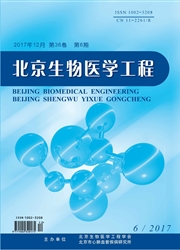

 中文摘要:
中文摘要:
如何长期高效地为植入式医疗器械提供电能已经成为一个热点问题,利用人体自身温差进行发电是很有潜力的供电方法之一。文中对此进行了动物实验研究,分别将普通热电片植入到兔子体内二个不同位置。结果表明,在常温环境中,兔子体内的最大温差可达1.3K,利用普通热电片进行热电转换所获得的输出电压为5mV;而在皮肤表面敷设冰块冷却状态下,热电片所获得最大温差可达5.5K,输出电压为25mV。说明动物体内存在着天然温差,且可借助外部冷却予以强化。考虑到近期逐步出现的一些可植入式微/纳米医疗器械的运行仅需微量电能,利用人体温差为其供电比较可行。
 英文摘要:
英文摘要:
How to power in long term an implanted medical device via a highly efficient way is a focus at present. Using the temperature difference existing inherently in human body to generate electricity is one of the most promising ways. This paper presents an in vivo experiment on such thermal electric devices, which are implanted respectively into three tissue positions of a rabbit. It was found that a maximum temperature difference of 1.3K and an output voltage of 5mV can be gained with an ordinary thermoelectric generator implanted into rabbit under normal environmental temperature. If covering the rabbit skin surface by a bag of ice water, the maximum temperature difference and the output voltage would increase to 5.5 K and 25 mV, respectively. These results indicate that temperature difference exists intrinsically over the biological body which can be further enhanced through external cooling. Considering that the working of some gradually emerging implanted micro/nano medical devices relies on only an extremely small energy, using such temperature difference to power them is very feasible.
 同期刊论文项目
同期刊论文项目
 同项目期刊论文
同项目期刊论文
 Evaluation on the capacity of selectively heating vessel-rich-skin to realize noninvasive whole body
Evaluation on the capacity of selectively heating vessel-rich-skin to realize noninvasive whole body Multiscale effect of localized heating on the global temperature response of a human body during who
Multiscale effect of localized heating on the global temperature response of a human body during who Monte-Carlo simulation on gold nanoshells enhanced laser interstitial thermal therapy on target tumo
Monte-Carlo simulation on gold nanoshells enhanced laser interstitial thermal therapy on target tumo Inhibition of B16 murine melanoma metastasis and enhancement of immunity by fever-range whole body h
Inhibition of B16 murine melanoma metastasis and enhancement of immunity by fever-range whole body h Development of interventional whole body hyperthermia system: Part I: Device fabrication and perform
Development of interventional whole body hyperthermia system: Part I: Device fabrication and perform Comprehensive evaluation on the heating capacities of four typical whole body yperthermia strategies
Comprehensive evaluation on the heating capacities of four typical whole body yperthermia strategies Development of interventional whole body hyperthermia system: Part II: In vivo animal experimental e
Development of interventional whole body hyperthermia system: Part II: In vivo animal experimental e 期刊信息
期刊信息
